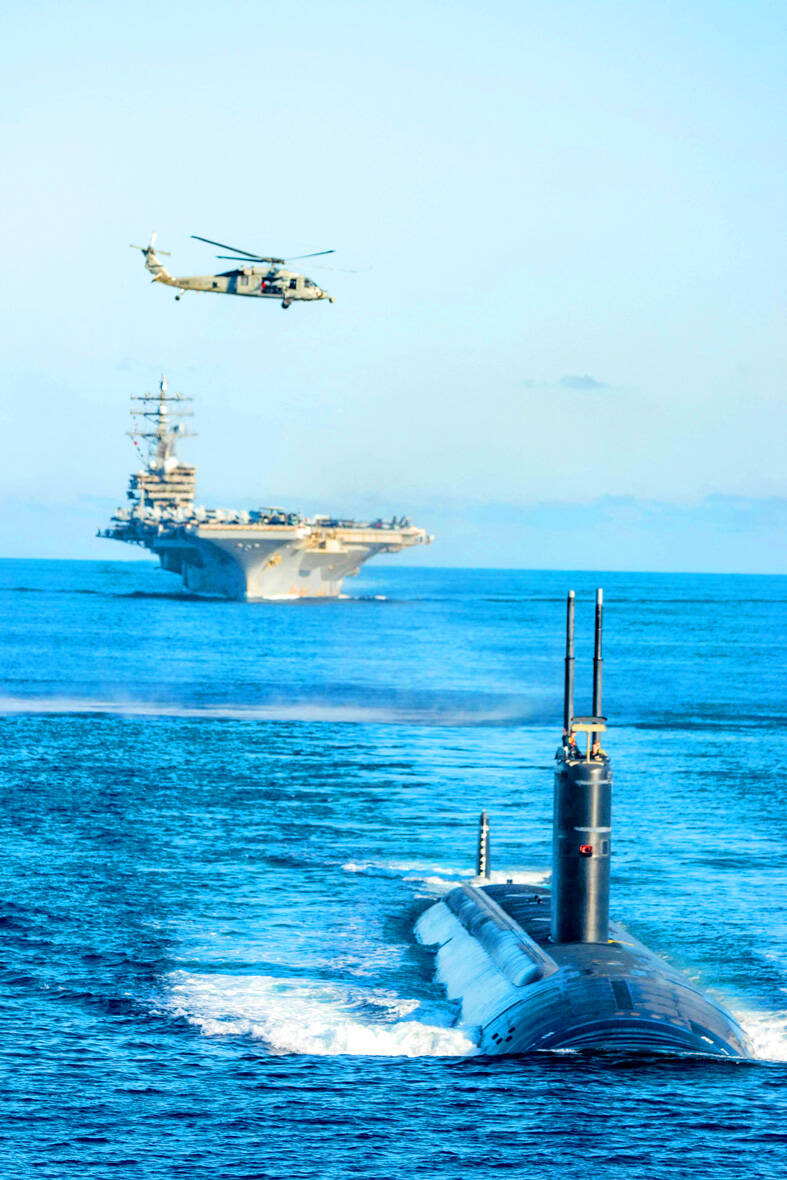The US military is considering modifying its command structure in Japan to better coordinate with the Japan Self-Defense Forces in a Taiwan contingency, the Nikkei Shimbun reported on Saturday.
The National Defense Authorization Act (NDAA) for fiscal year 2024 passed by the US Senate at the end of last month calls for the US secretary of defense to draw up a plan for enhancing US security cooperation with Japan, by coordinating and engaging with the joint headquarters of the Self-Defense Forces. The bill calls for the secretary to provide an analysis of the feasibility and advisability of modifying US command structures in Japan.
The new headquarters, which is expected to launch by March 2025, would oversee operations of all three branches of the Japan Self-Defense Forces, the Nikkei reported.

Photo: AFP / handout / South Korean Ministry of Defense
US President Joe Biden’s administration has begun initial discussions on the modification, people familiar with the matter told Nikkei, which added that the Pentagon declined to comment on the issue.
US House of Representatives Armed Services Committee Vice Chairman Rob Wittman voiced support for the Senate’s provision, saying that more time for operational coordination “sometimes can be the difference between victory and defeat,” the Nikkei reported.
The effectiveness of the coordination between the US and Japan should be constantly examined, he added.
The US command structure in Japan is expected to be one of the issues both chambers must address when they convene to draft a final text of the NDAA in the fall, the newspaper said.
As Japan implements its biggest defense reforms since World War II, the long-standing “sword and shield relationship” between the US and Japan is disappearing, it said.
Japan is acquiring long-range strike capabilities such as Tomahawk cruise missiles, and has indicated that it is more willing to get involved in military operations in defense of Taiwan, it added.
The US needs to establish joint command elements in Japan to avoid overlap in operations and ensure swift actions in a contingency, Japan chair at the Washington-based Center for Strategic and International Studies Christopher Johnstone said.
The US Indo-Pacific Command in Hawaii is in charge of coordinating with the Japan Self-Defense Forces, but remote coordination between Tokyo and Hawaii might be risky as China could disrupt communications with cyberattacks, senior political scientist at the RAND Corp Jeffrey Hornung said.
The US military established a Joint Support Force in Tokyo in 2011 to respond to the tsunami-earthquake and the meltdown of the Fukushima Dai-ichi nuclear power plant, the Nikkei reported.
The force, which was led by the commander of the Pacific Fleet, coordinated day-to-day operations and consulted with the Japanese government on joint responses, it said.
The experience indicated that the US lacked standing joint elements in Japan to facilitate coordination, said James Schoff, a senior director at the Washington-based Sasakawa Peace Foundation USA.
“Valuable time could be lost when responding to a crisis, and it will take a while for all participants to get up to speed,” he said.

An essay competition jointly organized by a local writing society and a publisher affiliated with the Chinese Communist Party (CCP) might have contravened the Act Governing Relations Between the People of the Taiwan Area and the Mainland Area (臺灣地區與大陸地區人民關係條例), the Mainland Affairs Council (MAC) said on Thursday. “In this case, the partner organization is clearly an agency under the CCP’s Fujian Provincial Committee,” MAC Deputy Minister and spokesperson Liang Wen-chieh (梁文傑) said at a news briefing in Taipei. “It also involves bringing Taiwanese students to China with all-expenses-paid arrangements to attend award ceremonies and camps,” Liang said. Those two “characteristics” are typically sufficient

A magnitude 5.9 earthquake that struck about 33km off the coast of Hualien City was the "main shock" in a series of quakes in the area, with aftershocks expected over the next three days, the Central Weather Administration (CWA) said yesterday. Prior to the magnitude 5.9 quake shaking most of Taiwan at 6:53pm yesterday, six other earthquakes stronger than a magnitude of 4, starting with a magnitude 5.5 quake at 6:09pm, occurred in the area. CWA Seismological Center Director Wu Chien-fu (吳健富) confirmed that the quakes were all part of the same series and that the magnitude 5.5 temblor was

The brilliant blue waters, thick foliage and bucolic atmosphere on this seemingly idyllic archipelago deep in the Pacific Ocean belie the key role it now plays in a titanic geopolitical struggle. Palau is again on the front line as China, and the US and its allies prepare their forces in an intensifying contest for control over the Asia-Pacific region. The democratic nation of just 17,000 people hosts US-controlled airstrips and soon-to-be-completed radar installations that the US military describes as “critical” to monitoring vast swathes of water and airspace. It is also a key piece of the second island chain, a string of

The Central Weather Administration has issued a heat alert for southeastern Taiwan, warning of temperatures as high as 36°C today, while alerting some coastal areas of strong winds later in the day. Kaohsiung’s Neimen District (內門) and Pingtung County’s Neipu Township (內埔) are under an orange heat alert, which warns of temperatures as high as 36°C for three consecutive days, the CWA said, citing southwest winds. The heat would also extend to Tainan’s Nansi (楠西) and Yujing (玉井) districts, as well as Pingtung’s Gaoshu (高樹), Yanpu (鹽埔) and Majia (瑪家) townships, it said, forecasting highs of up to 36°C in those areas